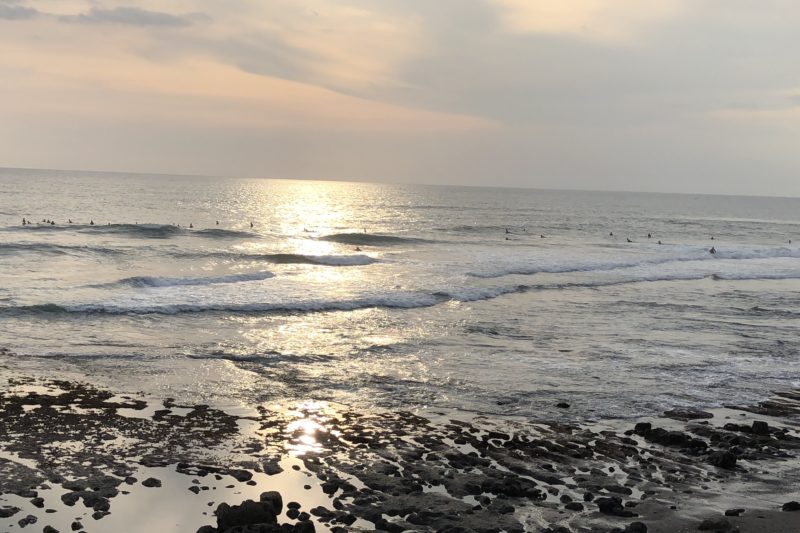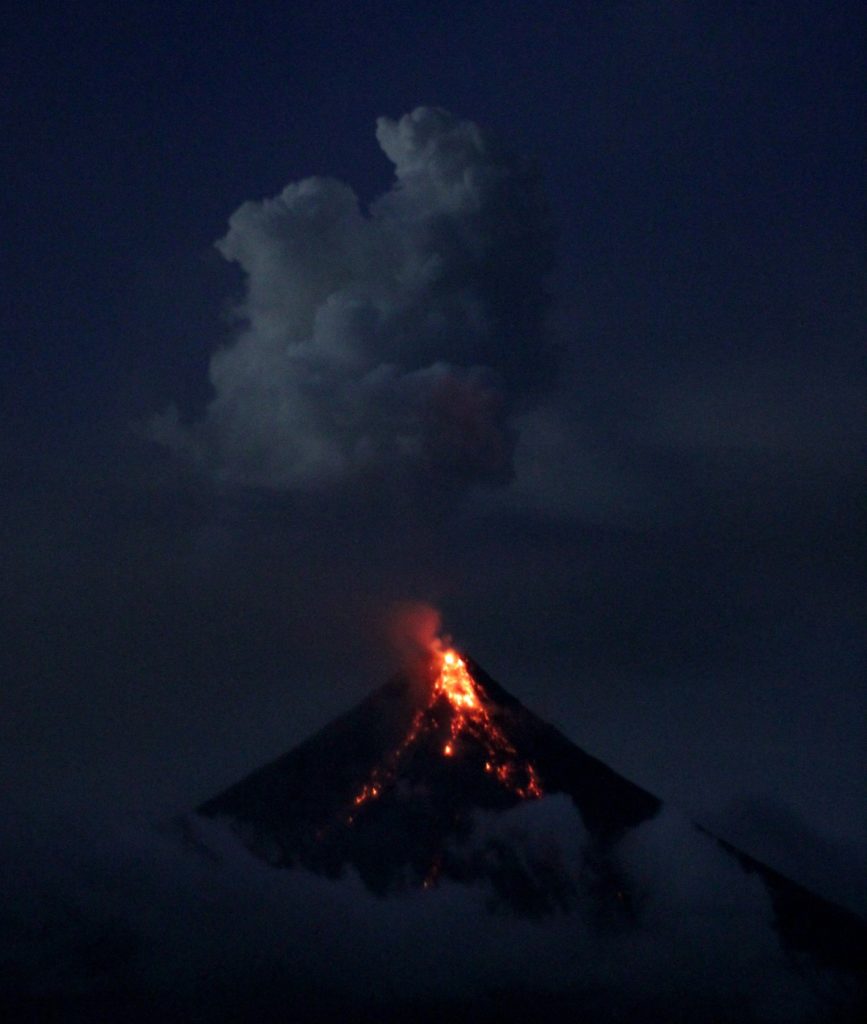
Let’s go arm chair travelling with Graeme Leith as he takes us on a Balinese fishing adventure.
Today was fishing day at Candi Dasa. It was arranged for Mider, who owns the boat, to collect me from the bamboo walled and thatch roofed hut “ A.1,” and we’d head off at 6 a.m. He was a little late, but that was easily explained when he came to fetch me at 6.10 a.m., he’d already prepared the boat and brought it around to the steps on the beach right in front of us here. Dawn was breaking by then, so I was able to leave my torch behind and head off with only a tube of suncream to weigh me down.
Mider had his young son with him, an alert and excited boy of about 8 years. It was not a school day for him today and he seemed very happy to be going to work with Dad. Mider’s boat is based on the original Bali model, which has a hull carved out from the trunk of a coconut tree, with outriggers to give it stability, but this is Mider’s new model with a fibreglass hull which gives it more flotation and more room within the hull. It can take more passengers which is important for Mider, as he can now take out a diving party of four or five, with their gear. But today there’s just me, Mider and his son.
Getting aboard is a difficult manouevre for me, with my titanium knees and tender footsoles, which makes it painful to walk over the crushed coral of which the beach is composed. Mider, on the other hand, walks over the beach with impunity, I’ve often seen him doing it with a 50 horsepower outboard motor on his shoulder. He’s a fine specimen of a man, the soles of his feet like leather. We idle out to the line of breakers and he waits for the ideal time to cross the reef. Shortly some large waves can be seen approaching the reef and he guns the motor so that our boat goes over the reef in high water. This is always the most exciting moment of the trip, unless you catch a mahi mahi. The motor roars and the spray flies as the craft slams through the breakers and the ropes holding the outriggers strain against the pressure, it’s just about worth the cost of the outing.
Today we are trying to catch a mahi mahi, a large fish about a metre or more in length, a ferocious fighter and very good eating, so the reward is good for they are in great demand from the warungs or cafes and the restaurants in this village and beyond. We settle down to our trolling speed and Mider’s son eagerly passes the bait bag containing the packet of small mackerel to his father who impales them on their treble hooks, drops them over the side and hands the fishing rod to me, for it’s my party and I’m paying for it, (though not much.) It’ll cost me about $A25 for the two hours or so and a fair bit of that is for petrol. I rent a little motorbike when I’m over here and if I do about 100 kms. a day the fuel costs me more than the ‘bike hire.
So we settle down to what I consider to be the boring business of trolling. It has none of the excitement of fly-fishing for trout, where you stalk your quarry or search for rising fish and then try to fool them with an artificial imitation of a small insect or other tiny creature that you may, for ultimate satisfaction, have tied yourself. But there is not much skill involved here. We motor on, our poor dead mackerel trailing behind us, but any monotony is overwhelmed by the crashing of the waves onto the small rocky islands around which we sail, trees and shrubs clinging to their sides like children to their mother’s skirts. The sun rises fully and breaks through the cloud in a phenomenal burst of fierce orange fire. I look to the shore, to the hills above which were invisible in the mist minutes ago and there, way above them, now visible through the dying mist, the mighty mass of the volcano Agung appears, a gigantic monolith seeming to rise to the very heavens, dark, majestic, powerful and threatening. I am reminded of “Gorrillas in the mist.” How it must have looked to the inhabitants in 1963, when it spewed out millions of tons of molten rock and lava which flowed to the sea, incinerating all in its path and turning the sky as black as night for days on end, the sulphurous fumes and the darkness destroying many crops that weren’t destroyed by that fearsome lava.
But the Balinese are philosophical about incineration, after all they quickly cremate and bury the remains of the dead, so that those remains can later be resurrected from the soil in which they were buried. Later a well organized burial ceremony and celebration of the deceased takes place, a religious observance, like so many in the world, that takes account of the local climatic conditions as well as satisfying the existing religious mores which seem to have been tailored around that climate. The Inuit people might leave their old and infirm to float away and die on a piece of ice. The Australian aborigines are reputed to have left the old and infirm behind to die so that the other more vigorous members of the tribe could maintain the required speed to take them to the next hunting or gathering ground. Survival of the fittest was necessary for survival of the very species and decaying bodies in a climate like that of Bali would pose the threat of disease to the remaining healthy populace.
And so the Balinese do not resent the mighty Agung but worship him, even though he takes lives, for they know that the lava will become fertile soil in time and that Agung has replenished the basis of their livelihood, the soil. In this climate the lava becomes fertile soil quite quickly, crops now grow on the soil created from the lava of the eruption of 1963, from our sturdy craft we see the coconut palms on the shore, growing in that very soil.

The boy, Mider’s son, is tiring now, he has been woken at an unusually early hour and as we motor on, the rocking of the boat in the waves and the monotonous drum of the motor are soporific. He lies down in the hull of the boat and sleeps, his face a picture of beatific calm. Mider’s eyes constantly scan the water for any sign of unusual movement, any nervousness on the surface that might indicate that the pelagic predator, the feared mahi-mahi is attacking mackerel below the surface, for if we see those signs we will quickly motor to them and trail our bait through the killing fields.
But today is not to be our day, nothing happens for almost an hour, then a couple of the other boats have a catch. We see them struggling to gaff fish and the boy is awoken by their shouts. He leans over the gunwhale of the boat, looking, tense with anticipation, almost quivering with excitement like a bird dog when it senses a quail or grouse; this boy has fishing in his blood, his very bones! But I am suddenly and unexpectedly repelled by the sight of the men gaffing the fish, as i see the cruel implement impale their living thrashing silver flanks and see the blood spurt out into the clear blue sea, and I know that this will be my last mahi- mahi fishing excursion.
“Let’s go home,” I say to Mider, “I think I’ll go to breakfast now.” Mider looks surprised but turns the boat for home. We easily navigate the bar, for the tide has risen. We moor the boat and I go to the dining room for breakfast-Bali coffee, three fruits and omelette, no fish!
 Graeme Leith is a regular contributor to Viva 70. Big thanks Graeme for generously contributing your stories. Graeme’s book Passing Clouds: A Winemakers Journey is published by Allen and Unwin
Graeme Leith is a regular contributor to Viva 70. Big thanks Graeme for generously contributing your stories. Graeme’s book Passing Clouds: A Winemakers Journey is published by Allen and Unwin
Words by Graeme Leith with thanks. Feature image by Nora Vitins
